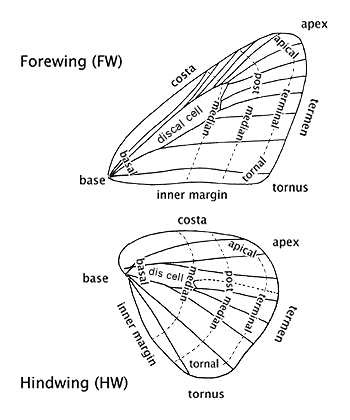| HW ground colour yellow suffused orange, with a broad straight pale-orange
post median band edged black, and a black tornal patch. Uppersides pale orange and black. Antennae
clubs strongly bent. May turn up in the Far North where palms are grown in gardens.
|
Cephrenes trichopepla
|
38-44 mm |
| HW ground colour yellow, with a single large white median discal-cell spot
edged black. Antennae clubs strongly bent
|
Trapezites luteus luteus
|
32-38 mm |
| HW ground colour creamy yellow, with a poorly developed, broad curved cream
coloured median band, diminishing towards both the costal and inner margins; broadly edged dark
brown (suffused yellow when the skipper is new), central outer side of band prominent, not double
pronged. Terminal wing margins chequered. Antennae clubs strongly bent. (Found in the Far North)
|
Croitana aestiva
|
24-34 mm |
| HW ground colour creamy yellow, with a broad curved cream coloured very
irregular median band, broadly edged dark brown (suffused yellow when the skipper is new),
central outer side of band double pronged. Terminal wing margins strongly chequered.
Antennae clubs strongly bent. (Found in the Far North)
|
Croitana arenaria arenaria
|
22-26 mm |
| HW ground colour creamy yellow, with a broad curved cream coloured very
irregular median band, broadly edged dark brown (suffused yellow when the skipper is new),
central outer side of band rounded, not double pronged Terminal wing margins strongly chequered.
Antennae clubs strongly bent. (Found on north Eyre Peninsula and further north)
|
Croitana arenaria pilepudla
|
28-32 mm |
| HW ground colour yellow, markings obscure, antennae clubs bent. FW upperside
brown areas dusted yellow. Male with a post median sex brand on FW upperside, broad shining black
and very obvious
|
Ocybadistes walkeri hypochlorus
|
24-26 mm |
| HW ground colour greenish yellow, an irregular yellow post median band
(paler than rest of wing), antennae clubs bent. Male with a post median sex brand on FW upperside,
broad shining black and very obvious. (Presently found in the Riverland)
|
Ocybadistes walkeri sothis
|
24-26 mm |
| HW ground colour yellow, but suffused brown when worn, an indistinct
discal-cell spot and short post median band (paler than rest of wing). Antennae clubs flattened,
spoon shaped, not obviously bent. Male with a narrow, obscure post median sex brand, discontinuous
and irregular. On forewing upperside, costal and postmedian yellow bands joined or nearly joined
apically. (Found in the Far North)
|
Taractrocera anisomorpha
|
21-26 mm |
| HW ground colour yellow sometimes suffused brown, with a straight white post
median band. Male with a very narrow, continuous post median sex brand, shining black. Antennae clubs
are flattened, spoon shaped, not obviously bent
|
Taractrocera papyria papyria
|
20-24 mm |
| HW ground colour yellow, suffused orange-brown, a yellowish discal-cell spot
and post median band (paler than rest of wing). Antennae clubs flattened, spoon shaped, not obviously
bent. Male without a sex brand. On forewing upperside, costal and postmedian yellow bands segmented
apically. (Likely to be found in the Far North)
|
Taractrocera ina
|
24-26 mm |
